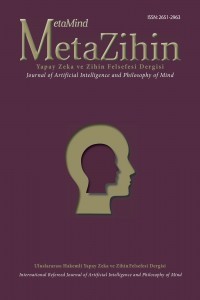Düşünce Deneyleri Doğallaştırıldı
düşünce deneyi, analitiklik, kavranabilirlik, modalite, Wittgenstein, dil oyunları
Thought Experiments Naturalized
thought experiment, analyticity, conceivability, modality, Wittgenstein, language games,
___
- Ayer, A. J. (1952). Language, Truth and Logic. New York: Dover.
- Gendler, T. S. (2000). Thought Experiment: On the Powers and Limits of Imaginary Cases. NY: Garland Press.
- Gendler, T. S. (2002). "Thought Experiment." In Encyclopedia of Cognitive Science. NY/London: Nature/Routledge.
- Gendler, T. S. (2004). “Thought Experiments Rethought—And Reperceived.” Philosophy of Science, 71(5): 1152–1163. https://doi.org/10.1086/425239
- Jackson, F. (1982). “Epiphenomenal Qualia.” Philosophical Quarterly, 32: 127–136.
- Kuhn, T. (1964). "A Function for Thought Experiments." Reprinted in The Essential Tension: Selected Studies in Scientific Tradition and Change (1977) (pp. 240-265). University of Chicago Press.
- Kuhn, T. (1977). The Essential Tension. Chicago: University of Chicago Press.
- Massey, G. (1991). "Backdoor Analyticity." In Horowitz, T. and G. Massey (Eds.), Thought Experiments in Science and Philosophy (pp. 285-296). Savage, MD: Rowman and Littlefield.
- Sorensen, R. (1992). Thought Experiments. New York: Oxford University Press.
- Wittgenstein, L. (1999). Philosophical Investigations. Oxford: Blackwell.
- Wittgenstein, L. (1972). On Certainty. New York: Harper Torch Books.
- ISSN: 2651-2963
- Yayın Aralığı: Yılda 2 Sayı
- Başlangıç: 2018
- Yayıncı: Murat ARICI
Düşünce Deneyleri Doğallaştırıldı
Prof. Dr. Celal Türer ile Söyleşi: Pragmatizm, William James’te Bilinç ve Benlik, Türkiye’de Felsefe
Murat ARICI, Bilge Ceren DEMİR
Nicholas Malebranche’da Zihnin İşlevi
Yanılsamanın Akla Yatkınlığı: Alternatif Olanaklar İlkesi, Özgür İrade ve Ahlaki Sorumluluk
